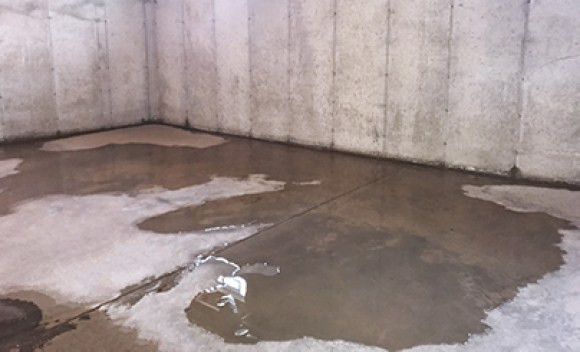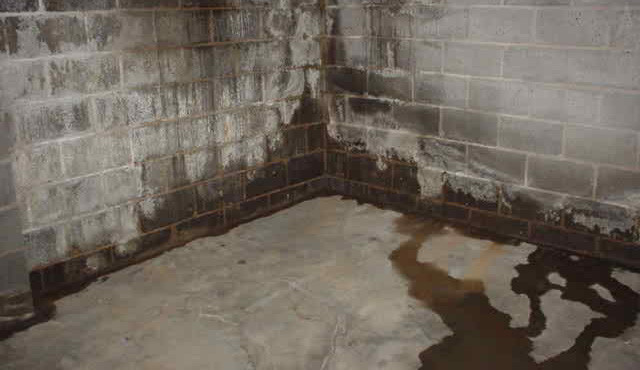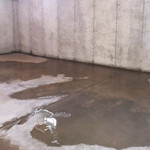Have you ever wondered how to effectively keep your basement dry, free from damage and potential health risks? It’s crucial to choose a waterproofing system that suits your basement’s specific conditions, whether that is sealing against condensation, addressing runoff, or combatting groundwater. It’s not a one-size-fits-all situation; your choice should depend on factors such as your type of foundation, existing damage, and budget constraints. As you weigh the benefits of various interior and exterior waterproofing options, don’t underestimate the value of expert advice. Stay tuned, there’s more to learn about this critical home improvement decision.
Key Takeaways
- Identify the source of water in your basement and evaluate the severity of existing water damage.
- Determine your foundation type and consider seasonal water issues for a tailored solution.
- Understand the pros and cons of different waterproofing systems, including interior, exterior, and combination options.
- Consider your budget and conduct a cost-benefit analysis, weighing the potential savings and risks of DIY versus professional work.
- Evaluate your DIY skills and the time commitment required, or consider the benefits of professional services, including expertise and guaranteed quality.
Understanding Basement Waterproofing
Understanding basement waterproofing is an essential step in protecting your home from potential water damage. It’s not just about keeping your basement dry; it’s about safeguarding your home’s structural integrity.
You see, when water seeps into your basement, it doesn’t just create a damp, unpleasant environment. It can also lead to mold growth, damage to your home’s foundation, and even potential health risks.
There are several types of basement waterproofing systems available, each with its own pros and cons. The key is understanding which system is best suited to your home’s specific circumstances.
Interior waterproofing, for example, is designed to manage water that’s already made its way into your basement, while exterior waterproofing aims to prevent water from entering in the first place.
Additionally, there are also drainage systems designed to guide water away from your home. You’ve got to take into account the type of soil around your home, the climate in your region, and the age and construction of your home when choosing a system.
Identifying Your Basement’s Needs
Evaluating your basement’s specific needs is your next essential step in choosing the right waterproofing system. Don’t just rush into buying the first system you come across. Instead, take a good, hard look at your basement first.
Start by identifying the source of water or moisture. Is it due to condensation, runoff, or groundwater swelling?
Condensation occurs when moist, warm air hits cool basement walls, while runoff is water that enters through cracks or holes. Groundwater swelling, on the other hand, is water that seeps in from the soil.
Next, examine the type of foundation your basement has: poured concrete, concrete block, or stone? Each material type can be vulnerable to different kinds of water damage.
Finally, assess the degree of water damage already present. If there’s minor dampness only during certain seasons, you may not need a heavy-duty system.
However, if water is pooling or if there’s significant mold growth, a more robust solution might be necessary.
Types of Basement Waterproofing Systems
There’s an array of basement waterproofing systems to pick from, each designed to tackle specific issues. Depending on your basement’s specific needs, one may work better than the other. It’s crucial to understand each system’s nature before making a choice.
Firstly, there’s the interior waterproofing, commonly known as water control. It doesn’t stop water from penetrating your basement walls. Instead, it manages the water that gets in, directing it to a sump pump system.
Exterior waterproofing, the most effective method, stops water from entering basement walls, thereby preventing the risks of structural damage. It’s usually applied during construction.
There’s also the interior and exterior drain tile systems. They prevent water accumulation around your foundation by guiding it away from your home.
Lastly, there’s the crack injection method, which is ideal for poured concrete foundations where leaks start through cracks in the walls or floors.
Here’s a quick overview:
| System | Description |
|---|---|
| Interior Waterproofing | Manages water that penetrates basement walls |
| Exterior Waterproofing | Prevents water from entering basement walls |
| Drain Tile Systems | Guides water away from the foundation |
| Crack Injection | Seals cracks in poured concrete foundations |
Pros and Cons of Different Systems
As you consider your options, it’s essential to weigh the pros and cons of different waterproofing systems.
Interior methods may offer cost-effective solutions, but do they provide the long-term protection of exterior techniques?
Let’s take a closer look at these approaches, along with the costs associated to help you make an informed decision.
Interior Waterproofing Methods
Choosing the right interior waterproofing method for your basement can be a complex task. Various factors such as cost, effectiveness, and the degree of your basement’s dampness should inform your decision. You’ve got a lot to reflect upon, but don’t worry, we’re here to help you navigate through your options.
Let’s discuss two popular methods: sealants and water control systems. Sealants are applied to walls and floors, creating a watertight seal. They’re affordable and easy to apply, but they can’t fix existing water damage or prevent future leaks.
Water control systems, on the other hand, are more extensive. They redirect water from your basement to a sump pump, which then pumps it outside. This method is highly effective, but it’s also more expensive and requires professional installation.
Here’s a quick comparison table:
| Method | Pros | Cons |
|---|---|---|
| Sealants | Affordable, Easy to apply | Can’t fix existing damage, Can’t prevent future leaks |
| Water Control Systems | Highly effective, Redirects water outside | More expensive, Requires professional installation |
Exterior Waterproofing Techniques
While interior methods certainly offer a valuable line of defense against water invasion, it’s worth exploring the benefits of exterior waterproofing techniques. These methods aim to prevent water from ever reaching your basement walls.
Exterior waterproofing includes the application of sealants and the installation of drainage systems. Sealants form a protective barrier on your home’s exterior, blocking water from seeping through the walls. They’re often applied when the home is being built, but can also be added later.
Drainage systems, on the other hand, divert water away from your home’s foundation. These include gutters, downspouts, and specially designed drains around the perimeter of your home.
But, there are drawbacks. Applying exterior sealants can be challenging and time-consuming, especially for existing homes. It often involves excavating around the home’s perimeter, which can be disruptive and costly.
Drainage systems require regular maintenance to keep them free from blockages.
Despite these challenges, exterior waterproofing techniques are an effective way of safeguarding your basement against water damage. They provide a robust, first-line defense that, when combined with interior methods, can guarantee your basement stays dry and damage-free.
Waterproofing System Costs
Steering through the myriad of basement waterproofing systems might feel overwhelming, especially when you consider the costs.
Being aware of the potential expenses can help you make an informed decision.
The cost of waterproofing your basement can vary greatly depending on the system you choose.
Exterior systems, for instance, are usually more expensive as they require significant excavation. However, they offer a thorough solution by preventing water from entering your basement in the first place.
Interior systems, on the other hand, are less costly and easier to install. They manage water that enters your basement but don’t prevent it. You’ll save money upfront, but the potential for future water issues remains.
Then, you have the cost-effective water-resistant paints or primers. They’re easy to apply and can reduce dampness. But, they’re not a long-term solution and can’t handle serious leaks.
Lastly, you’ve got sump pumps, which are a middle-of-the-road option. They’re more effective than paints but less extensive than full exterior or interior systems.
Assessing Your Budget
Diving into the domain of basement waterproofing, your budget is a key player that needs careful evaluation.
It’s essential to take into account not only the upfront costs of materials and labor, but also long-term expenses such as maintenance and potential repairs.
Start off by determining how much you’re willing and able to spend. This will help you narrow down your options and make more informed decisions.
Remember, it’s not wise to skimp on quality for the sake of saving a few bucks now, only to shell out more money later for fixes.
Next, do your homework. Research the market rates for different waterproofing systems and services in your area.
This will give you a ballpark figure of what you can expect to pay. You should also factor in additional costs like inspections, permits, and potential structural modifications.
Lastly, put some money aside for unforeseen expenses. In any renovation project, there’s always a chance of running into unexpected issues that can inflate your budget.
DIY vs. Professional Installation
Now, let’s consider the choice between doing it yourself or hiring a professional.
First, it’s essential to honestly assess your DIY skills, as basement waterproofing can be a complex task.
Then, understanding what professional services offer and conducting a cost-benefit analysis will help you make an informed decision.
Assessing Your DIY Skills
Before starting a do-it-yourself basement waterproofing project, it’s crucial to honestly evaluate your own skills and abilities. This isn’t a job to be taken lightly; it requires a solid understanding of building construction, knowledge of waterproofing techniques, and a fair amount of physical work.
Reflect on your past DIY projects. Were they successful? Did you enjoy the process? Your answers will help you assess your readiness for a basement waterproofing project.
Here are four key areas to reflect on:
- Knowledge: Do you understand the basics of basement construction and the principles of waterproofing? If you’re starting from scratch, it could be a steep learning curve.
- Experience: Have you undertaken similar home improvement projects before? Experience in areas such as plumbing or carpentry could be beneficial.
- Time: A DIY basement waterproofing project can be time-consuming. Do you have the time to dedicate to this project?
- Physical ability: The job can be physically demanding. Are you up to the task?
Understanding Professional Services
After evaluating your ability to undertake a DIY basement waterproofing project, you might find that professional services could offer a more efficient solution.
Engaging a professional team guarantees you’re tapping into years of experience and specialty skills. They’re equipped with the right tools and materials, and they’re knowledgeable about the latest waterproofing technologies. This could mean a more thorough job and a longer-lasting result.
But it’s not just about the technical aspects.
Professionals also understand local building codes and regulations, which is vital if you’re planning on remodeling or selling your house in the future. They’ll make certain your basement meets all necessary standards, saving you from potential legal troubles down the line.
The choice between DIY and professional services often comes down to your personal comfort level, time availability, and the complexity of the job.
If you’re dealing with minor seepage, you may be able to fix it yourself. But for more severe issues, or if you’re unsure about the root cause, it’s wise to consult a professional. Their expert advice can save you from costly mistakes and provide peace of mind that your basement is properly protected.
Cost-Benefit Analysis
Weighing the costs and benefits of DIY versus professional basement waterproofing is an essential step in your decision-making process.
You might be tempted to save money by doing it yourself, but consider these four points:
- Time Investment: DIY projects can take longer than expected, especially if you’re not an expert.
You could spend hours researching, buying materials, and actually doing the work. Is your time worth the savings?
- Quality of Work: Professionals have years of experience and can guarantee their work.
Can you match their quality and guarantee your basement remains dry?
- Cost of Materials: Pros have access to high-quality materials at wholesale prices.
If you go the DIY route, you’re likely to pay retail.
- Potential for Error: Mistakes can be costly.
If you mess up, you might end up paying for professional repairs anyway.
In the end, you need to decide if the potential savings outweigh the risks.
Waterproofing System Maintenance
Keeping your basement waterproofing system in top condition is essential for its longevity and effectiveness. Regular maintenance isn’t just about preventing future issues, it’s also about identifying potential problems early and addressing them before they escalate.
Start with routine inspections. You should check your basement regularly for any signs of water intrusion, such as dampness, mold, or a musty odor. You’ll also want to inspect your waterproofing system. If you’ve installed a sump pump, for example, it should be tested and cleaned frequently.
Don’t forget to replace the battery backup every two to three years.
Moreover, pay attention to the exterior of your home. Clear your gutters and downspouts regularly to prevent water from pooling near your foundation. If your home’s landscaping slopes towards your house, you may need to rethink regrading it.
Maintenance can extend the life of your waterproofing system and keep it functioning properly. It’s an ongoing task, but it’s certainly worth it to keep your basement dry and your home structurally sound.
Key Takeaways for Waterproofing Success
How can you guarantee the success of your waterproofing efforts? The answer lies in understanding and implementing the key takeaways from a successful waterproofing process.
Ensuring the effectiveness of your waterproofing system isn’t a one-time task. It requires ongoing attention, regular maintenance, and the right approach.
Here are four key points to evaluate:
- Choose the Right Waterproofing System: Evaluate factors like the structure of your basement, local climate, and the level of water exposure while selecting the system.
- Professional Installation: Don’t compromise on the quality of installation. Hire professionals with a proven track record in waterproofing basements.
- Routine Maintenance: Waterproofing systems need regular check-ups and maintenance. Keep an eye out for any signs of deterioration or leakage.
- Quality Materials: Invest in high-quality materials for long-term results. Cheaper options might save you money initially but can lead to significant expenses in the future.
Conclusion
To sum up, isn’t a dry, safe, and reliable basement what we all seek? Choosing the right waterproofing system isn’t just about spending money, it’s about understanding your basement’s unique needs, evaluating your budget, and considering maintenance. Whether opting for DIY or professional installation, remember that a well-protected basement is an investment in your home’s longevity and value. Knowledge is power, and in this case, it’s also the key to a dry basement.





